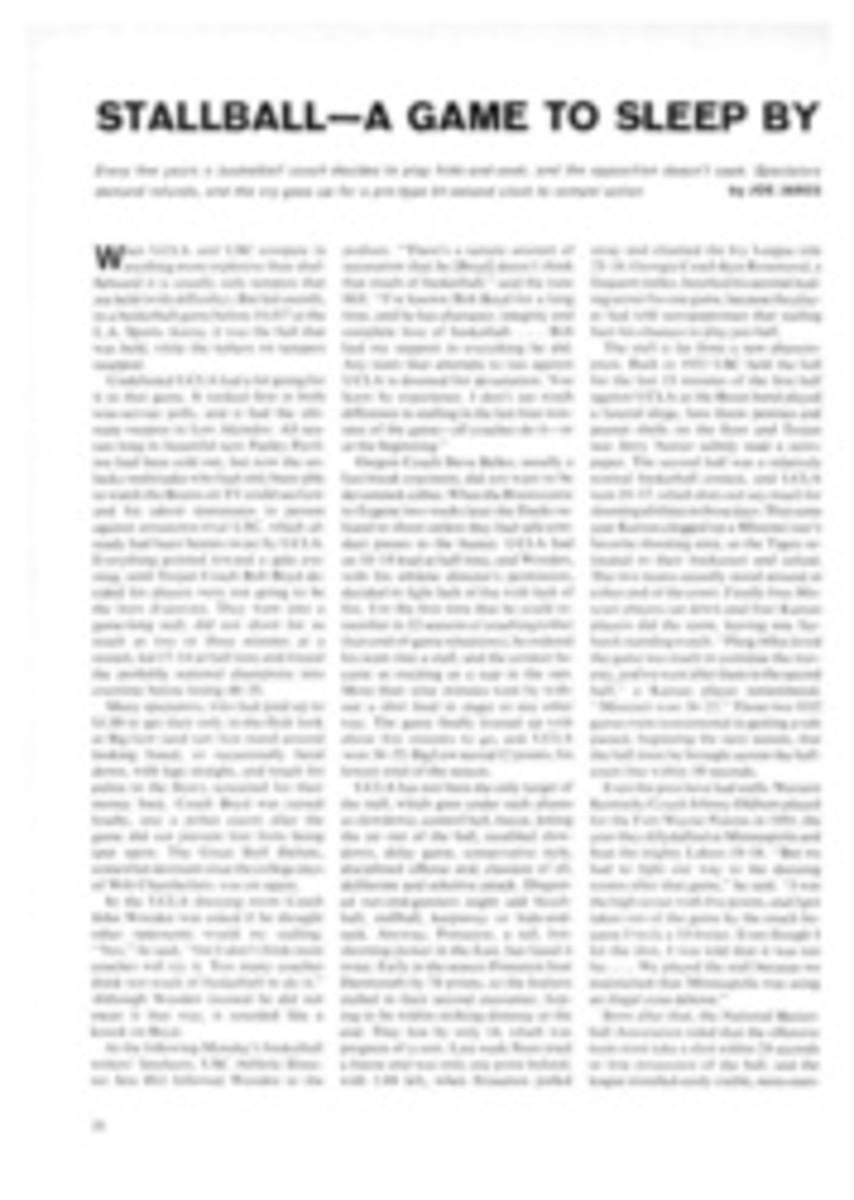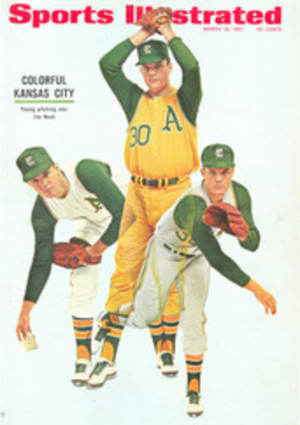
Two times one equals zero
It was last November when Wally Dill, the director of the professional tennis players association, got together with Freddie Botur, the pro at the 71st Regiment Armory on 34th Street in New York and worked out the details for an indoor tournament. Available were several members of the old guard, such as Rod Laver and Pancho Gonzalez, and two rookies, Dennis Ralston and Fred Stolle, as well as assorted members of pro tennis' taxi squad. Dill chose the dates of March 2-5 to hold the tournament and then proceeded to let no one know. "Why should we tell the USLTA?" said Dill. "They don't tell us anything."
Darn right. When Geza Gazdag, the pro at the nearby Vanderbilt club, a remodeled television studio inside Grand Central Terminal, decided to hold a tournament at his place, he certainly saw no reason to tell Dill. Gazdag lined up Manuel Santana, Arthur Ashe, Chuck McKinley and John Newcombe, and chose the dates of March 2-5. No two people were more surprised than Dill and Gazdag when the conflict in dates was made public, and by then it was too late for either to switch. So it was that last week New York had two tennis tournaments at the same time within a 10-minute walk of each other.
The timing error was just the first of the problems that confronted the tennis fan—and a relatively minor one at that. Thanks to the efforts of Gladys Heldman of World Tennis, the two tournaments agreed to stagger their playing hours. On one day you could see the pros at 5 in the afternoon, then scoot eight blocks up Park Avenue to catch the amateurs at 8. Difficult, but possible.
Worse were the prices, nothing under $6, some seats as high as $10. And to sit where? The dank, shadowy Armory was hardly better than a dungeon, and its inadequate lighting had Gonzalez raging, though that is nothing new. "Here I get myself into good shape and now I have to play in this," the old lion roared. "If you don't improve the lights, I'll default." The lighting was improved, pronto.
There was room for 6,500 people in the Armory, but with the exception of the Sunday final it was always less than half full. And there was one pitiful moment—5 p.m. on Thursday, the day the tournament began—when there were no more than 75 people in the gloom. The amateurs in the Vanderbilt club had better lighting, but the club's odd shape—very long and barely as wide as the court itself, sort of like, uh, well, an old television studio—prevented more than 1,400 at a time from watching. Most of the week there were fewer than 500 people, friends of the family. A college basketball doubleheader in Madison Square Garden on Thursday night drew 12,000 and thereby nearly matched the total attendance of both tournaments.
In an attempt to beef up its show, the amateurs staged a two-day preliminary team event at which fans were encouraged to shout and whistle, just as they would at a baseball game. Before a match between Istvan Gulyas of Hungary and Frank Froehling, the umpire announced: "Please don't refrain from booing or cheering." A few people gave it a try—a whistle here, a shout there—but none of it sounded natural. At one time someone coughed just as Froehling was about to serve. Froehling turned and fixed the person with an angry stare. When Santana was playing, Andres Gimeno, his former Davis Cup teammate, now a pro, shouted: "Spaniard, go home." it was a good moment, but even Gimeno looked a little embarrassed. "Tennis is a nice, respectable game," said Gussie Moran later. "Why try to ruin it?" End of experiment.
Despite the poor lighting and sparse crowds, the play in the pro tournament was excellent and pointed up three things: Rod Laver continues to be the best player in the world, Dennis Ralston is not yet ready to take that title away from him and, finally, old Pancho Gonzalez is still the game's biggest attraction. There were only eight players in the "tournament," so it wasn't exactly Laver against the world, but he ran through Fred Stolle, Earl Buchholz and Gonzalez, losing only two sets. One of those sets went to Gonzalez, who played Laver even to 5-5 in the third set. At that point Gonzalez put on another explosive display, storming to the net to accuse Laver of quick-serving him. The tantrum boomeranged, however, as Laver ran off eight of the next 10 games to win in four sets.
It was not astonishing that Ralston, making his U.S. pro debut, was dumped out of the tournament by Buchholz in the first round—Buchholz was gunning for him and he played extremely well—but it was disappointing nonetheless. Ralston had done extremely well in Australia, playing even in 10 matches against Fred Stolle, whom he could never, never beat as an amateur, and holding a combined 5-2 edge over Laver and Ken Rosewall. Perhaps the reason for his good play in Australia and New Zealand was that the matches were, in effect, exhibitions. Now that he is playing in tournaments there is more pressure, and Ralston still suffers in tight situations. It is a fault he will have to correct. Something more tangible that needs improvement is his serve. Set point against Kramer or Gonzalez and you knew either could pull it out with a big one. Set point against Ralston and he's in deep trouble.
As for Gonzalez, he is still magnificent. Pancho is 38 and his reflexes have slowed, but he is lean and fit and he knows how to play tennis. As he proved last week, it takes more than a Pierre Barthes or Andres Gimeno to beat him. And wherever Gonzalez goes, so goes the crowd. The first night he appeared from the dressing room just before his match and sat down in the temporary stands to file his callouses and wrap his fingers in adhesive tape. Laver and Stolle were close by and were nearly trampled to death by a swarm of kids who gathered around the aging giant.
The amateur tournament was more of an exhibition, played in a round-robin format on a slow, simulated-grass surface that allowed good rallies. (The pros' surface was faster—rubber stretched over board.) But even in an exhibition 22-year-old John Newcombe of Australia, who reached the finals at Forest Hills last summer, indicated that he will be tough to beat from now on. His serve is, with the possible exception of Ashe's, harder than any other amateur's. Manuel Santana, the artful Spaniard, was playing his first tournament since his ankle operation, and it was apparent that it is still giving him trouble. Edison Mandarino, the Brazilian who beat Ralston in the fifth set at Porto Alegre and thereby eliminated the U.S. from the Davis Cup, played well, saying that he liked the sound of hitting the ball in the old TV studio. Chuck McKinley bounded about the court in his usual gymnastic style, but Wall Street is taking its toll around his middle. Because the amateurs presented so many players—10 in all, some of them such relatively new faces as Hungary's Gulyas and Ion Tiriac of Rumania—it was in a way a more interesting show than the pros.
By coincidence, Herman David, the chairman of the All England Club, which runs the Wimbledon tournament, chose last week to level a blast at U.S. tennis officials for resisting open play, pointing out that weekly salaries to Davis Cup players (SI, July 18, 1966) surely makes them professionals. "It is the quintessence of hypocrisy," he said. Mr. David is, of course, correct, although it is all of amateur tennis that is guilty. The Davis Cup salaries merely bring the money question into the open. Santana didn't come from Spain, nor Newcombe from Australia, to play for kicks. In New York last week it was a good question which group of players was making more money.
Certainly the two tournaments helped emphasize how foolish it is to keep the pros and amateurs eight blocks apart. As long as tennis continues this practice, it can expect to hold its show in dungeons and abandoned studios. It can also expect continued second-class status.
So here is a suggestion. Maybe next winter Mr. Wally Dill can get together with Mr. Geza Gazdag and perhaps the two of them can find money to lease the new Madison Square Garden. Then, if nothing better, they can hold at least a pseudo-open tournament: first match Laver-Ralston, second match Newcombe-Santana. Watch both the pros and the amateurs for the price of one ticket (and lower those prices), without the inconvenience of an eight-block walk. It's worth a try.
PHOTO
AT ITS WORST, EARLY THURSDAY EVENING, THE PRO TOURNAMENT WAS PLAYED AGAINST A VAST BACKDROP OF EMPTY SEATS
PHOTO
AGING GONZALEZ IS STILL A BIG DRAW

